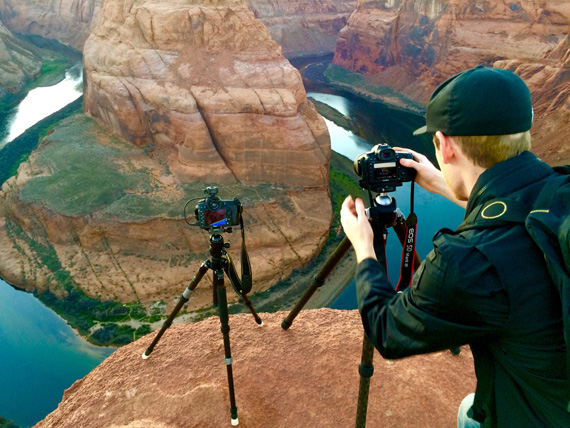When photographing landscapes, it is essential to have the correct meter setting activated to achieve proper exposure results. The meter setting on your camera helps you decide what combination of aperture and shutter speed to use in order to get a correctly exposed photograph. All cameras are different, but should have similar “on board” camera meters. I use a Nikon DSLR and there are three meter settings: Spot, Center Weighted, and 3D Color Matrix. Let’s discuss all three and compare and contrast the benefits of each. I will then explain which meter setting I use all the time, and how to get the most out of each setting while in the field.

Photo captured by dsdddsphotography
The spot metering setting meters a circle 4mm in diameter (approximately 1.5% of frame). The circle is centered on the current focus point, making it possible to meter off-center subjects. Wherever your main point of focus is, the camera will meter off this subject and calculate the correct aperture and shutter to use. You will dial in the aperture and shutter manually by adjusting them on the camera. When using spot metering, your main point of focus will be exposed properly. However, this does not mean the rest of the photo will be exposed properly. It is very frustrating at times when using spot metering because the first photograph taken is usually severely underexposed or overexposed. Since the success rate is low, you will have to constantly adjust the aperture or shutter to get the exposure you desire.
Center weighted metering meters the entire frame but assigns greatest weight to the area in the center of the frame (defaults to 12mm in the center of the viewfinder). Center weighted metering is like a cross between spot and 3D Color Matrix. If the photographer wants to meter off a specific tone or color, or something that is continuous throughout the frame, spot and center weighted metering will work very well. The best advantage when using center weighted metering is to “expose for your brightest highlight” because you can aim the meter point to the brightest highlight and ensure it is not overexposed.

Photo by Marcus Balcher; ISO 50, f/2.6, 1/800-second exposure.
The third meter setting is 3D Color Matrix. This setting is recommended in most situations. The camera meters a wide area of the frame and sets exposure according to distribution of brightness, color, distance, and composition for natural settings. Personally, I only use 3D Color Matrix when I am photographing for correct exposure. 3D color matrix calculates the correct exposure more than 90% of the time, without having to toggle the aperture and shutter buttons. This decreases incorrect exposures and nearly ensures that when you press the shutter release, the photograph will record properly, thus capturing the fleeting scene. Also, if the exposure is overexposed or underexposed, there is minimal effort to correct it since the correct exposure setting is relatively close to the meter reading suggested by the camera.
The meter setting in photography is very important not because of creative control, but from a time perspective. Time is of the essence in photography, and your photograph’s success can be determined by a fraction of a second. For this reason I use 3D color matrix all the time when photographing. I’ve tested and tried spot and center weighted, but find them too inconsistent to trust when photographing fleeting moments. I’ve been in situations where the photo is ruined because it is underexposed or overexposed and the experience/moment will never repeat itself. Therefore, not only is the meter setting important to get correct exposures, but it is the most reliable when photographing a new scene for the first time without previous meter readings.

Photo by Indigo Skies Photography; ISO 200, f/8.0, 0.8-second exposure.
I do find some uses for spot metering however. When I am using special graduated neutral density filters, I find that taking a meter reading of the shaded area and the bright sky at the horizon help me choose what strength of filter to use. For instance, I have filters that are 1 stop, 2 stop, and 3 stop in strength. If the spot meter reading indicates that the shaded area of my photo is best exposed at f4 and shutter 1/10 and then indicates that the bright horizon is best exposed at f4 and shutter 1/80, I know to use the 3 stop filter because the range of light values between the shaded region and the horizon is 3 stops. I use spot metering exclusively for this method of calculating the strength of light in different zones. For all other purposes, my camera is always set to 3D color matrix.
About the Author:
This article was written by Stefan Hofer (stefanhofer.org). A creative photography enthusiast.
Like This Article?
Don't Miss The Next One!
Join over 100,000 photographers of all experience levels who receive our free photography tips and articles to stay current:






I don’t have a 3D Color Matrix setting on my Nikon D200 camera. What setting should I use for landscape shooting then. I mostly shoot sunrise landscape shots. Thanks for your article, very interesting. Trish
Is anyone but me sick to death of long exposure seashore pictures? Was kinda neat in 2000, but now it’s hackneyed beyond belief. Please no more!
Thanks Stefan,
My first D700 just arrive on Tuesday, I am breathtakingly confused at the moment but I will be taking your advise here with the D Colour Matrix. Great article and photos.
thanks for sharing..it was very helpful to me..thanks a ton..keep up the goood work..
all the best :)